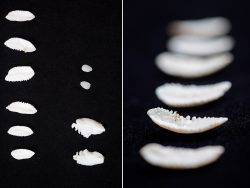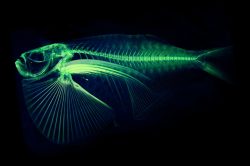
How much can you really learn from a dead herring in a jar?
Housed in the UW College of the Environment, the Burke Museum’s Ichthyology Collection is home to more than 13 million preserved fish specimens from around the world, many dating back over a century. By far the largest collection of its kind in North America, it includes over 300 different samples of Pacific herring — an ideal species for researchers aiming to look back in time.
A small and unassuming fish, the Pacific herring is a staple of the Puget Sound ecosystem and is a key prey species for larger, culturally and commercially important species such as salmon. From a single preserved sample of these herring, researchers can learn about a surprisingly broad swath of our oceans’ history and future, from changes in physiology and parasite abundance over time to ocean chemistry and climate change.
Parasites and our warming oceans
“When you put a fish in a jar, you have preserved everything about it at that point in its life when it died,” said Katherine Maslenikov, collections manager at the Ichthyology Collection. “So you’ve got its stomach contents, its parasites, pretty much everything — all that ecology is here.”
The small marine parasites found in the collection’s preserved herring were recently used in a study that sought to understand how they had changed in Puget Sound over the last 100 years. According to the study, led by Associate Professor of Aquatic and Fishery Sciences Chelsea Wood, Puget Sound has actually seen about an 11% decline per decade of complex lifecycle parasites — the ones that exist in different life stages depending on the host of the parasite — driven largely by climate change and our warming ocean temperatures.
“Parasite ecology is really in its infancy, but what we do know is that these complex-lifecycle parasites probably play an important role in pushing energy through food webs and in supporting top apex predators,” Wood said.
This research is not only important for our understanding of how ecosystems will respond to climate change, but also represents an entirely new way to use the collection, opening up new avenues for future research.

What fish ear bones can teach us about climate change
Pacific herring, along with all fish except sharks, rays and lampreys, have a small inner-ear particle known as an otolith. These stone-like particles are used to allow fish to sense vibrations and maintain balance in the water. Historically, otoliths have been used to determine the age of fish specimens, much like the rings on a tree help to determine its age — each ring on an otolith indicates another year of that fish’s life.
Recently, advances in laser technology have allowed researchers to use these otoliths to understand historical ocean chemistry. Within each otolith there are traces of ocean elements — oxygen, carbon, nitrogen and others — and by shaving off tiny slivers of specific otolith rings with lasers, researchers can discern the relative levels of those ocean elements at a specific point in the fish’s life. And if they know the age of the fish, they can work backwards to reconstruct an understanding of ocean chemistry through time.
It’s then possible to track these trends over time and better understand how increasing sea surface temperatures have changed aspects of a fish’s life cycle, such as by forcing them into deeper, colder waters at much earlier life stages than historically documented.
“By studying those elements, you can tell when a fish left warmer surface waters and went deep,” said Maslenikov. “You’ll see in the otolith the age at which they did that.” This new technique presents an incredible opportunity for climate research, and with over 2.5 million otoliths in the collection, the Pacific herring is just the tip of the iceberg.

Sharing the collection with the world
Given the massive size and scope of the Burke’s Ichthyology Collection, efforts are underway to help share its impact around the globe. These same Pacific herring are part of a global project to document every species of fish on Earth in 3D. Led by Adam Summers, professor of aquatic and fishery sciences at the UW’s Friday Harbor Labs, the openVertebrate Network (oVert) aims to CT scan a specimen from every genus of the world’s vertebrates and upload them into an open-source online database for researchers to use and reference around the world.
A CT scan of a fish captures a huge amount of information about its skeleton, internal organs, muscles and even the aforementioned parasites that were present when it died. From the CT-scanned repertoire of fishes and other vertebrates, researchers can examine thousands of samples through a non-destructive method and expand access to the collection beyond the Burke’s walls.
Historically, museum collections like the Burke’s have primarily been used for anatomical and genetic studies, but thanks to the development of these new technologies and innovative research techniques, the collection is being opened up to a wide array of new projects.
“What we’re hoping is that as more studies are published this way, people will start to realize that there’s this historic record that exists,” said Maslenikov. As for the humble Pacific herring, the future may see even more unexpected ways that it can help us understand our planet.
Story by Ellie Mason

